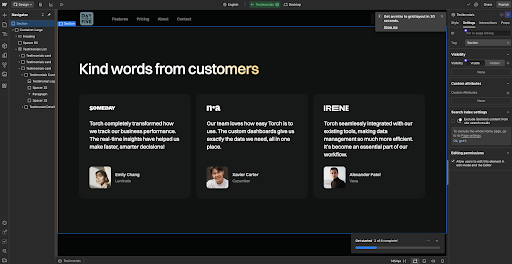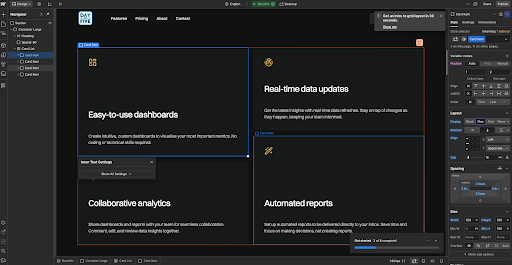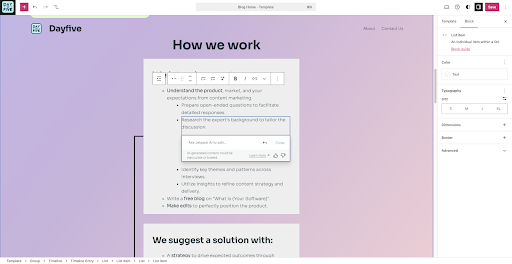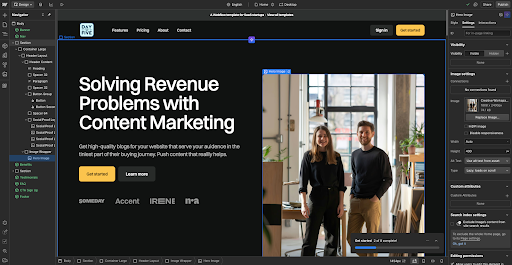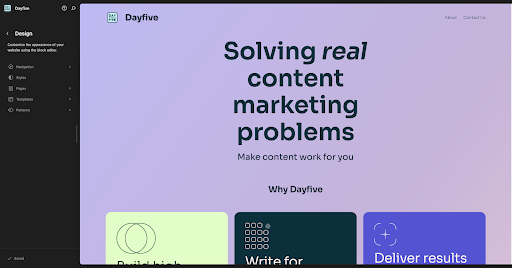When evaluating website builder platforms, it is essential to align both your business and team expectations.While searching for the perfect tool to create my own digital portfolio, I explored some of the most popular options — Webflow and WordPress. This led me to run a direct comparison between the two to understand how they measure up.While Webflow offered intuitive and responsive graphics, WordPress focused more on seamless APIs, a UI-friendly IDE, and exception handling. To keep my comparison objective and decision-focused, I also compared the two tools based on real-time G2 reviews and stacked them against each other. Here’s a quick feature comparison of both website builder platforms.
Webflow vs. WordPress at a glance
| Feature | Webflow | WordPress |
| G2 rating | 4.4/5 | 4.4/5 |
| Best for | Building product or service websites with a modern user interface | Creating blogs or building scalable websites |
| E-commerce tools | User-friendly tools are built directly into the platform, which is ideal for small to medium-sized stores. | Powerful e-commerce capabilities through plugins like WooCommerce, suitable for all sizes of businesses. |
| Security and compliance | Fully managed, less control, built-in SSL & security. | Self-managed, high control, full compliance possible with manual setup. |
| Integrations | Offers integrations with marketing automation tools like HubSpot, Mailchimp, Zapier, Formstack and so on. | Supports integrations like WooCommerce, HubSpot, Mailchimp, Yoast SEO, Ecwid, Omnisend and AI tools like Kodee. |
| Customization (Design and backend) | High design flexibility, limited backend, better for smaller-scale projects | Unlimited front & backend control, scalable to any size |
| Design and templates | Highly visual drag-and-drop design interface. Modern, responsive templates optimized for designers seeking customizations. | Huge variety of free and premium themes. It offers complete customization through themes and code, which is ideal for those who want maximum control but require technical knowledge. |
| SEO and performance | Built-in, streamlined SEO tools and clean code structure. Excellent site speed and mobile responsiveness. Automatic SSL and optimized hosting. | Strong SEO capabilities using plugins like Yoast and Rank Math. Site performance depends on hosting choice and configuration; it requires user-managed optimization. |
| Free plan | Yes, with pages and content management system (CMS) items capping. | Offers a free plan with a WordPress domain. |
| Pricing |
Starter: $0/month Basic: $14/month
CMS: $23/month
Business: $39/month |
Personal: $4/month
Premium: $8/month
Business: $25/month
Commerce: $45/monthEnterprise: Approx $25000/year |
Based on initial understanding, Webflow is best if you prefer ease-of-use, modern design, and built-in performance without needing extensive technical skills. On the other hand, WordPress is great for maximum flexibility and extensive plugin support. If you’re comfortable managing the technical aspect or have the support of a developer, WordPress is a good platform.
Note: The details below reflect the products’ current capabilities as of August 2025. Both companies constantly add advanced features; some capabilities may change over time.
Before we begin the head-to-head testing, I want you to examine the web builder platforms and their features more closely. They’re both impressive. But the devil’s in the details, isn’t it? Let’s break down and see what sets them apart.
Webflow vs. WordPress: What’s different?
Below is an overview of the key differences between Webflow and WordPress.
- Platform type: I found Webflow to be a complete visual web design platform with a CMS and built-in hosting. You get full visual design freedom with cascading style sheets (CSS)- level styling via drag-and-drop. It’s built for pixel precision. On the other hand, WordPress presents a fully managed blogging and website platform built on WordPress core. Its design is based on pre-built themes. If you need customization beyond theme, you’ve got to be on a business plan or higher. Customization beyond themes often requires a Business plan or higher. WordPress is more suitable if you can code to include the required customizations. Webflow is a more appropriate choice for creating attractive websites without knowing much coding.
- E-commerce support and CMS functionality: Webflow eCommerce is native. It supports products, checkout, taxes, shipping, etc. I feel it’s suitable for small stores. On the other hand, e-commerce is available via WooCommerce (only on the Business plan or higher) in WordPress, which offers higher scalability. For the CMS, WordPress delivers classic posts/pages and custom post types. You can go in-depth by using plugins. While Webflow offers built in CMS, and plugins integrated in one platform, it’s still a smaller range as compared to WordPress’s dynamic library.
- SEO tools: Webflow offers built-in SEO tools with options to edit meta title, descriptions, alt text, and add 301 redirects and an extensible markup language (XML) sitemap for power users. Webflow has also integrated hosting (powered with AWS and CDN), built for speed, scalability, and security, unlike WordPress. In WordPress, you get basic SEO on the lower plan. The Yoast plugin is available on Business+ plans, requiring you to spend more. This creates a hurdle as you can’t optimize for SEO from day one (considering you’re on a Personal or Premium plan). Webflow doesn’t limit you this way. I was able to optimize from the initial start in Webflow.
- Localization and multilingual support: Webflow now offers native localization features (introduced in late 2023 and expanded in 2025) that let you manage multiple language versions within the same project, with visual editing for each variant. In WordPress, multilingual functionality requires plugins like WPML, Polylang, or Weglot, which can be powerful but add maintenance complexity and potential plugin conflicts. If you want multilingual right out of the box, Webflow’s approach is simpler, though WordPress offers more flexibility for highly customized localization workflows.
- Enterprise collaboration: Webflow’s Workspace plans provide team-level collaboration with role-based permissions, staging environments, and publishing controls. They also integrate with tools like Jira, Asana, and Slack for workflow alignment, making it straightforward for design, content, and marketing teams to work in parallel without developer bottlenecks. In WordPress, enterprise collaboration is usually achieved via third-party plugins, custom workflows, or managed enterprise WordPress services (e.g., WordPress VIP), which offer far deeper scalability and governance but require a more complex setup.
Webflow vs. WordPress: What’s similar?
There are a few similarities between the two platforms, including:
- Website building capabilities: Both Webflow and WordPress allow users to create websites with blogs, portfolios, and even e-commerce stores without actually coding them, except when complex customizations are needed. They support a fully responsive design. Webflow uses visual breakpoints, while WordPress themes often come mobile-optimized. For us, this means we don’t need to code to design a website; we can do it by using simple drag-and-drop elements.
- Third-party integrations: Both Webflow and WordPress facilitate integration with tools like Stripe or Mailchimp. WordPress integrates virtually with any tool through plugins and application programming interfaces (APIs), while Webflow integrates via native or third-party embeds. Both let you connect with external tools like CRMs, email marketing platforms, analytics, and e-commerce systems, enabling workflows that go beyond the default features.
- Community and resources: Webflow and WordPress have large, active user communities. You get to access community resources in the form of Q&As in forums. Both platforms have a decent volume of tutorials, helping beginners navigate any learning curve they might face.
How I compared Webflow vs. WordPress: My evaluation criteria
In my previous jobs, I spent almost one year on each Webflow and WordPress platform. I fairly understand the nitty-gritty of the two platforms. However, for this comparison, I decided to build from scratch to refresh and update my knowledge.
I tested both the tools for designing a homepage of a marketing services website for a brand, Dayfive. I compared Webflow and WordPress for user-friendliness, flexibility, design features, SEO, performance, and pricing.
I spent a week testing both platforms to explore all their features and avoid missing anything important. My goal was to find a user-friendly interface that made customization easy, so the testing criteria reflected that. For this, I used a mix of basic and advanced design elements to create a visually appealing website with the right functionality.
Having built several simple websites for my services and startups, I approached this comparison with experience and objectivity. I used the same content and features on both platforms; only the design and stock images varied.
Now, let’s dive into the actual testing and see how Webflow and WordPress perform side by side.
Disclaimer: This comparison is based on my hands-on experience with the two website-building platforms as of August 2025. Some features and functionality may have evolved since. I recommend referring directly to Webflow and WordPress’ official resources or support teams for the most up-to-date information.
Webflow Vs. WordPress: How they actually performed in my tests
I explored both platforms in-depth, highlighting why certain features stand out and what they mean for real users. By testing each tool, I uncovered its strengths and limitations for a clear, hands-on comparison. Curious about the results? Let’s get started!
User-friendliness and flexibility
I started with Webflow. Signed in and chose a template; we’re already in.

As someone with prior design experience, I find it amazing and easy to navigate and fiddle with. Unfortunately, if you’re not into the UI/UX side of things or an “artist,” you’ll be bombarded with a clean screen but overloaded with buttons and settings.
Now, that “get started” tutorial, although annoying, is great. It has small videos that show you exactly what to do if you’re new. The platform is fairly flexible and great for designing the front end.
You can get into the details and fiddle until you correct it. The layers system is still complicated to understand if you’re entirely new. Honestly, it’s a bit tough to arrange things using their layers system for me as well, but then again, at least I don’t have to learn HTML and CSS to do something about the looks, and I am happy with that.
I experimented with Webflow’s CMS. While user-friendly, it requires some time to fully utilize its potential.

Webflow also has many app integrations, such as Figma, Zapier, and Loopie, for animations and other functionalities.
To experiment with WordPress, I chose the “Lativ” theme and worked around the home page’s content.

I found WordPress to be super easy to use, especially for beginners. The UI is clean and doesn’t bombard you with too much information. A normal person who has experience with Microsoft Word or Google Docs can easily create a website with WordPress.
I liked Webflow’s templates to be much prettier than WordPress. However, you need sufficient time to get a fully functional website. You get a code editor on WordPress, which you can use to customize the site more extensively.
Overall, both Webflow and WordPress are great tools for designing a website from scratch. However, WordPress would be easier to work with for an absolute beginner as the user interface is super clean, saving complexities for later. For user friendliness and flexibility, I’ll go with WordPress.
Winner: WordPress 🏆
Design features and capabilities
From a design standpoint, Webflow and WordPress offer decent tools and functionality. I found Webflow to be more visually customizable than WordPress. Webflow offers a components feature that allows you to reuse elements on different pages once you have created them. This can be something as simple as a collection of testimonials. If you modify a collection, it gets modified in all instances.
Webflow does offer flexibility here. If you wish to change only one collection instance, you can go to settings and create a new property. This will make changes only in that particular instance.

You get options to change the layout of elements on the page with simple button clicks. It’s super easy to transform a block layout into a grid or a flex. This makes it easy to work with the website builder software.
Webflow allows access to the complete design tool on the right-hand side panel. You can change the margins, typography, color, padding, icon, images, and even the tiniest things you see on the page.

WordPress, on the other hand, keeps its UI clean but makes a trade-off with the extent of design features it offers to customize elements on a page visually. On the right-hand menu, you can configure fonts, dimensions, color, etc. However, the options are limited.
For more extensive customizations, you’ll have to get technical help from someone who can code. For developers, WordPress is highly customizable (more than Webflow.) However, coding takes a lot of time.

When it comes to editing line items, WordPress offers AI assistance to generate/edit text on the go. It becomes easier to take inspiration through AI and self-edit different textual elements on the page.

Webflow does offer an option in its CMS to auto-populate sample blogs, but it’s currently beta-testing. This is useful if you’re designing for a client and want to add some placeholder elements to give them an overview.
From a features perspective, Webflow offers better ways to customize the website, which is useful for beginners visually. You can do the same with WordPress, but it requires time and coding. Sure, WordPress plugins help, but you need to add custom code for advanced customization.
Winner: Webflow 🏆
Content and SEO
WordPress is known for blogging and content. I found nothing in my test inspiring me to challenge this statement.
I’d primarily write about WordPress and Webflow’s content and SEO features based on my experience (one year each) in working with these tools. Webflow’s content management system (CMS) is initially tricky to navigate. You need to do more monotonous and repetitive work, for example, manually writing the Author’s name or bio every time you publish a blog. This was the case with me.
Optimizing the platform’s title, meta description, and alt text was easy from an SEO standpoint. However, the platform doesn’t keep up when you’re working extensively toward off-page optimization. For example, when you link extensively to other websites in stat roundups, there was no easy way to add a “no-follow” attribute to links.
Comparing this directly with WordPress CMS, you can edit the link and check the no-follow attribute. It was super easy to do on WordPress. It offered a range of plugins to make our work easier. For example, the Yoast plugin helped a lot in optimizing the on-page elements of a webpage.
On a general note, WordPress offers a range of plugins that allow you to perform diverse actions if you don’t want to write code.
From a technical SEO perspective, working with the WordPress CMS was relatively easy as it allows us to add Schema markup in JSON to the custom code. In my experience, I didn’t find this option to do it easily on Webflow.
Winner: WordPress 🏆
Pricing
Webflow offers a free plan. Its basic plan starts at $14 per month and delivers all the features necessary for realistic static websites. The CMS plan, priced at $23 per month, is suitable for websites heavy on dynamic content. Larger business websites that need more flexibility can go with the $39/month plan.
There are optional add-ons like:
- Optimize: Costs $299/month to maximize site conversions.
- Analyze: Starts at $29/month to help you get actionable insights on your site’s performance.
- Localization: Allows users to localize a website for audiences around the world. It starts at $9/month.
On the flip side, WordPress.com offers the following plans:
- Personal: $4/month
- Premium: $8/month
- Business: $25/month
- Commerce: $45/month
Additional costs apply when you add paid plugins or choose a paid theme to create your website.
Winner: Split
Webflow vs. WordPress: Head-to-head comparison table
Here’s a table showing the web builder software that wins.
| Feature and functionality | Winner | Why it won |
| User-friendliness and flexibility | WordPress🏆 | WordPress is more user-friendly. When users start, they aren’t bombarded with tons of features and complexities. |
| Design features and capabilities |
Webflow 🏆 | I liked Webflow’s extensive customizability (visual). It allows beginners or non-designers to ramp up quickly and bring their web pages into the daylight. |
| Content and SEO | WordPress 🏆 | I felt WordPress has more features and functionality when it comes to catering to SEO and content use cases. You can use different plugins to complete your job effectively. |
| Pricing | Split | Both platforms have fairly reasonable pricing. It’s best to package the best of both platforms together. Many design agencies offer the front-end on Webflow while their CMS is on WordPress. This offers stunning design with visual customizability in addition to a scalable CMS. |
Key insights on Webflow vs. WordPress from G2 data
I looked at review data on G2 based on real users’ experiences to find strengths and adoption patterns for Webflow and WordPress. Here’s what stood out:
Satisfaction ratings
- Webflow excels in ease of use (84%), ease of setup (88%), and ease of doing business (92%).
- WordPress ranks high in ease of use (87%). However, it shows decent satisfaction ratings for ease of doing business (87%) and ease of setup (84%).
Industries represented
- Webflow dominates in design, marketing, advertising, IT services, computer software, and graphics design.
- WordPress has a strong presence in marketing and advertising, IT services, computer software, the Internet, and writing and editing.
Highest-rated features
- Webflow excels in visualization tools (88%), hypertext markup language (HTML) and CSS Editors (85%), and content elements libraries (85%).
- WordPress stands out for visualization tools (88%), content elements libraries (88%), and templates library (86%).
Lowest-rated features
- Webflow struggles with marketing tools integration (77%), vector graphics tools importing and integration (80%), and WYSIWYG editor integration (81%).
- WordPress also struggles with vector graphics tools importing and integration (83%), WYSIWYG editor integration (84%), and marketing tools integrations (85%).
Webflow vs WordPress: Frequently asked questions (FAQs)
1. How do you migrate from WordPress to Webflow?
Start by auditing your WordPress site and exporting content via the built-in tool or a plugin like WP All Export. Import the data into Webflow’s CMS, rebuild your design, replace WordPress-specific plugins with Webflow features, update SEO settings, and test thoroughly before launch.
2. Which website builder is the best?
There isn’t a one-size-fits-all answer—it depends on your goals. Webflow, WordPress, Wix, Shopify, and Framer are all popular choices, so the best builder is the one that fits your design, customization, and business needs.
3. Do I need a CMS for my website?
A CMS is essential if you plan to manage dynamic content like blogs, product pages, or frequently updated sections. For simple or static sites, you can skip a CMS and use a lightweight builder or custom code instead
4. How many pages are allowed in Webflow for free?<!–
The free Webflow plan allows up to 2 static pages (such as Home and About). To unlock more pages or CMS functionality, you’ll need to upgrade to a paid plan.
5. Does Webflow host your website?
Yes. Webflow includes secure hosting with fast load times, backups, and SSL certificates. You can also export code to host your site elsewhere if preferred.
6. How long does it take to make a website with Webflow?
A simple one-page site can take a day or two, while a small multi-page site (4–5 pages) may take up to a week. The total time depends on your design complexity and required features..
7. Which is more customizable, Webflow or WordPress?
WordPress is more customizable overall, offering vast plugins, themes, and backend control. Webflow provides strong design flexibility but less backend extensibility.
8. Is Webflow or WordPress better for e-commerce websites?
WordPress (with WooCommerce) is more powerful for complex stores thanks to deep customization and scalability. Webflow suits smaller shops that prioritize sleek design and ease of use.
9. How does WordPress compare to Webflow for SEO?
WordPress offers stronger SEO flexibility with advanced plugins like Yoast and Rank Math. Webflow has solid built-in SEO tools, but fewer customization options overall.
10. How do Webflow and WordPress compare for website speed?
WordPress offers stronger SEO flexibility with advanced plugins like Yoast and Rank Math. Webflow has solid built-in SEO tools, but fewer customization options overall.
Webflow vs. WordPress: My final verdict
WordPress has been around for a long time, since 2003, while Webflow came out in 2012. Both platforms offer diverse functionality when it comes to web design. Plugins on WordPress make many jobs easier than when you try them on Webflow. However, Webflow is easier to customize and doesn’t require you to know coding to implement customizations.
You can customize WordPress to a certain extent, but beyond that, you need technical web development expertise. This makes Webflow easier to use.
Overall, Webflow is a good starting point for businesses as it offers many customization options to create a stunning UI. WordPress is great for mature companies with more complex needs and scalability requirements. Many companies simply use Webflow for the front end and WordPress for the back end, giving them the best of both worlds.
The “best” among the two will largely depend on what you expect from the tool. Curious about other web builder software?
Check out the top Webflow and WordPress alternatives on the market.
This article was published in April 2025 and has been updated with new information.
Sagar Joshi
Sagar Joshi is a former content marketing specialist at G2 in India. He is an engineer with a keen interest in data analytics and cybersecurity. He writes about topics related to them. You can find him reading books, learning a new language, or playing pool in his free time.
